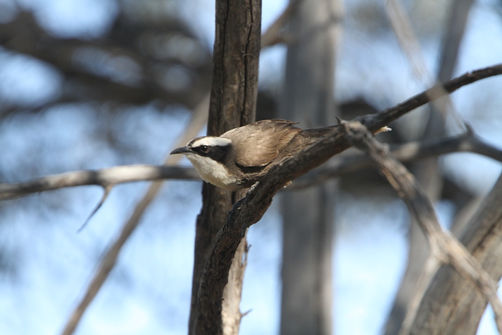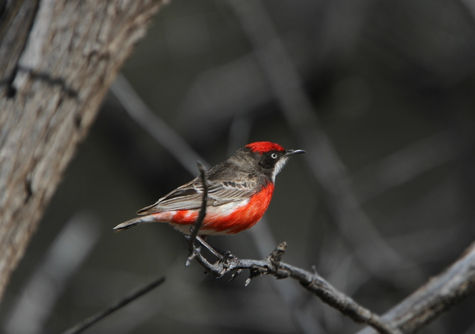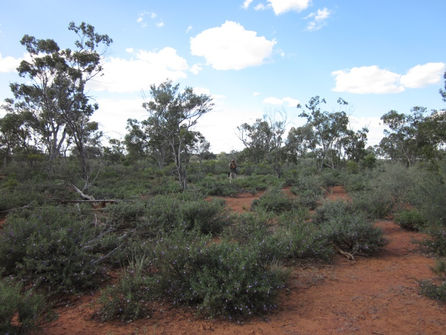
Great Channel Country
Tour Overview:
The Australian Outback holds an allure for many travelers to Australia, especially birders. Leaving from Brisbane, this short trip to south-western Queensland is easy birding, and is designed to fit nicely around other travels in the region. It targets parts of Australia few other tour companies visit, and we will get some birds that are not possible on any other scheduled tour. Birds at the margins of their inland range will be our main targets, including the communal Hall’s Babbler, elusive Chestnut-breasted Quail-Thrush and charismatic White-browed Treecreeper. We penetrate far enough into the Outback to have a chance at the secretive Grey Grasswren, and if conditions are suitable, we may find the enigmatic Flock Bronzewing. We will also pick up a swag of parrots, including the beautiful Pink Cockatoo and perhaps the more understated Bourke’s Parrot. South-western Queensland is also a hotspot for Australian raptors, with up to 18 species possible including the Black-breasted Kite, and if we are very lucky, the extremely elusive Grey Falcon.
Upcoming Departures:
Detailed Itinerary
Other Tour Information:
Length: 8 Days
Starting City: Brisbane
Ending City: Brisbane
Pace: Moderate
Physical Difficulty: Easy
Focus: Birding, Photography
Max group size: 8 + 1 leader
Day 1: Arrival into Brisbane
There is no birding on this day, which starts with a dinnertime meet up to discuss plans for the following day.
Day 2: Brisbane to St. George
We leave Brisbane very early this morning, giving us the opportunity to do some birding as we cross the Great Dividing Range. While the main targets of this tour are the inland specialties, it is hard to drive straight past very cool birds such as Rainbow Lorikeets, Pale-headed Rosellas and Crested Pigeons. We take in some good birding spots on the west slope of the range, where we will start getting a taste for some of the birds that inhabit Australia’s dry interior. We spend the night at St. George.
Day 3: St. George to Cunnamulla
Today we strike deep into the heart of south-western Queensland, and can expect to see our first real inland birds. An early start will ensure that we take advantage of the cool morning temperatures, possibly encountering our first flocks of Budgerigars, Pink Cockatoos, and if we’re lucky, some of the more difficult inland birds like Red-backed Kingfisher. We will arrive in Cunnamulla by lunch, and spend the afternoon birding the amazing Bowra Station. Here our main targets will be the difficult trio of Hall’s Babbler, Chestnut-breasted Quail-Thrush and White-browed Treecreeper. Night in Cunnamulla.
Day 4: Cunnamulla to Noccundra
We rise early to bird Bowra again, continuing the search for any birds missed the previous afternoon. We will keep our eyes peeled for Chirruping Wedgebill, Redthroat and Bourke’s Parrot, as well as a wide selection of honeyeaters, finches, woodswallows and thornbills. Even the common birds here are spectacular, like Red-capped Robin and the azure jewel of the inland, Splendid Fairy-Wren. South-western Queensland is also the heart of raptor country, so wherever we are, we will be keeping our eyes on the skies for Black-breasted Kites, Spotted Harriers and the very rare Grey Falcon. After leaving Cunnamulla we will be heading to the Noccundra Hotel for the next two nights, a true-blue Australian Outback experience!
Day 5: Noccundra to Cooper’s Crossing and back
Now we get to the great Channel Country, our furthest point into the Outback, complete with red sand, ephemeral watercourses and lignum swamps. The birding will depend on local conditions, and if we are lucky we may get the chance to chase some of the more enigmatic inland birds. The birding here can be slow, but the rewards are immense. Irruptive species like Little Buttonquail and Flock Bronzewing are possibilities, while at Cooper’s Crossing we scour the lignum swamps for the extremely elusive Grey Grasswren. We will return to Noccundra at dusk for a cold beer and well-deserved dinner.
Day 6: Noccundra to St. George
Hopefully at this stage we will have seen most of our target birds, but if not we have time to try again for anything we are missing. We will be passing the well-known birding locations of Lake Bindegolly and Eulo Bore, both worthy of a stop. After a huge trip, and with our list of inland birds burgeoning, we depart the Outback as we return to St George.
Day 7: St. George to Brisbane
Our final day will be spent returning to Brisbane. Our list will already be long, but as we ascend the western slopes of the Great Dividing Range we will have time to stop for many of the more widespread species we may have neglected earlier. This day may yield our longest birdlist with multitudes of honeyeaters and parrots. We arrive in Brisbane in the early evening with time for a final group dinner and wrap-up checklist. Night in Brisbane.
Day 8: Departure from Brisbane
This morning you will be transferred to the airport for your flights home.
Trip Considerations
PHYSICAL DIFFICULTY: This is an easy trip with no difficult walking involved. However, it is fast-paced, and you can expect to be starting very early on most days, departing the hotels between 3:30am and 5:00am, and having breakfast in the field. These early starts aren’t just for fun, they will get you many more birds and allow us to visit more locations and habitats during the brief cool mornings.
CLIMATE: Hot days and cool nights. Rain is highly unlikely (we can hope!).
ACCOMMODATION: Outback pubs. That can be hard to explain – think about being on the set of a Crocodile Dundee movie! You’ll get hot water everywhere, but will have shared bathrooms in some localities. Contact us about more details related to accommodation.



















